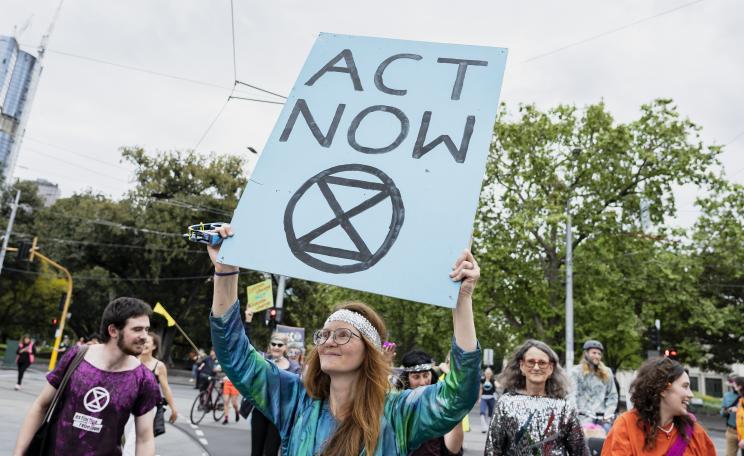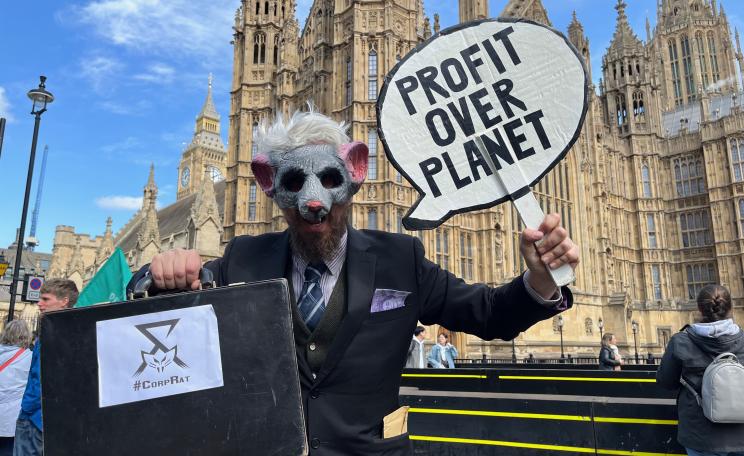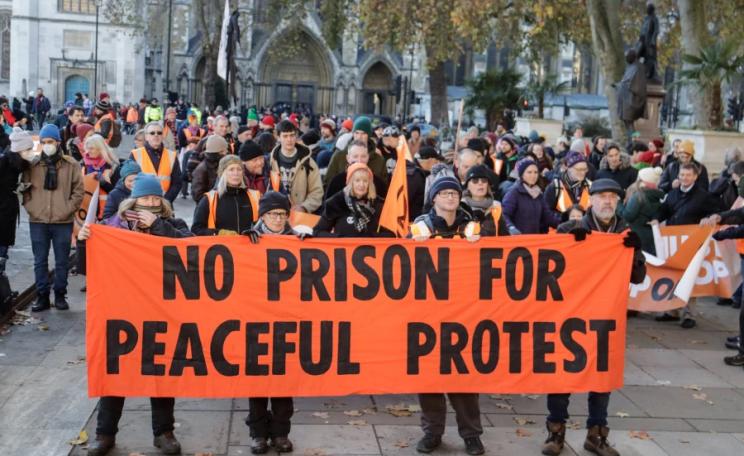It’s by either refusing to go home, or coming back day after day, that we’ll create enough pressure that change will ultimately come.
On 31 December 2022 Extinction Rebellion UK announced it was quitting. Not all climate activism, it soon became clear, but one brand of climate activism in particular. “We make a controversial resolution to temporarily shift away from public disruption as a primary tactic”, a statement read. “We must be radical in our response to this crisis […], even if it means taking a different approach than before.”
LISTEN: Eat Sleep Protest Repeat.
This article was first published at Novara Media. You can support its work by donating here.
The group’s new approach has been to get serious about mass mobilisation, prioritising “attendance over arrest” and “relationships over roadblocks”. Following a countdown of actions over 100 days, the group is now in the final stage of its preparation for ‘The Big One’: getting 100,000 people to surround the Houses of Parliament 21-24 April. This won’t just be a mobilisation of your standard XR ‘rebels’ either, but participants from 94 supporting organisations including social justice groups, trade unions and big NGOs.
This is a far cry from the XR of 2018 and 2019. Back then, the movement made its name with a repertoire of disruptive and often scandalous direct actions: blocking roads, staging funerals, spraying fake blood and taking their clothes off. Its methods achieved real wins, and in the process exposed the failings of the wider climate movement. With its new direction – however temporary – is XR forsaking what gave it its power?
It’s by either refusing to go home, or coming back day after day, that we’ll create enough pressure that change will ultimately come.
‘The next few layers of the onion’
It’s fair to say that a lot has changed since 2018. “We don’t live in the same world as we did when we launched”, says Clare Farrell, one of the founders of XR who’s still deep in the trenches today. “People do actually know they’re totally fucked because of the climate now.”
XR can take some credit for this. Public concern about the climate crisis saw a sharp uptick following its protests in 2019, with three in four adults reporting feeling worried about climate change today. “Once you’ve got a population who are showing that level of consciousness, […] the conversation kind of turns to: ‘Well, where is everyone?’,” she explains.
The wider activist landscape looks different too. In recent years, XR offshoots Insulate Britain and Just Stop Oil have taken on the role it formerly played as the climate movement’s ‘radical flank’, with XR’s own actions no longer getting the attention they once did. Meanwhile, since the demise of the youth strikes, the space for a mass climate movement has been left unoccupied.
As such, at the end of 2021, many inside XR started thinking about how to recruit activists in far greater numbers. Tim Jones, who’s been involved since 2018, explains that those who came to the first wave of actions were often mobilised through XR’s ‘Heading for Extinction’ talk, which was delivered nationwide. “We realised that we’d probably saturated that market […] because most of the people who are going to join [via that route] would have joined already,” he says. “We needed to bring in the next few layers of the onion, so to speak” – those who are worried about the climate crisis, but aren’t yet doing anything about it.
For those who spoke to Novara Media, there’s hope that a departure from XR’s trademark tactic – getting as many people arrested as possible – will help with this. “At the beginning, there was a lot of criticism that we were, you know, glorifying arrest, which was alienating for a lot of people – people of colour, people like myself”, says Nick Anim, who got involved in XR in 2019. “This shift is very much hoping to address that.”
Alanna Byrne, another longtime organiser, explains that XR is also trying to shake off the image of the hippy-dippy climate activist. “Boris Johnson, in 2019, he called us ‘crusties’, and that label stuck,” she recalls. This intensified during the pandemic when they couldn’t go out and meet people face to face and were further ‘othered’ by the rightwing press. XR’s reorientation, then, is about showing that they’re not “just a bunch of activists”, but rather “ordinary people from different backgrounds”.
This shift – and the shift away from the arrest tactic in particular – wasn’t uncontroversial within the movement. Some of those I spoke to said other activists argued that the urgency of the moment demands disruption, and worried that XR might lose what made it distinctive.
“Yes, this might not work,” Jones acknowledges. “But we have to try something different.”
Deep canvassing
How to mobilise people en masse became the core focus of a small group of XR activists in 2022. From this grew ‘Project 3.5’: a campaign which takes its name from the work of Erica Chenoweth, a political scientist whose research into non-violent civil disobedience found it takes 3.5 per cent of the population participating in protests to achieve political change (“although we don’t think there’s anything particularly magical about that number,” says Jones).
With the help of Becky Bond, former advisor to Bernie Sanders, and Joe Todd, previously at Momentum, the group arrived at the idea of ‘deep canvassing’: knocking on people’s doors and listening to their concerns. “We didn’t want to just go and lecture people about what the problem is,” says Jones, who became a coordinator of the project. “We needed to go and listen to people […] and then tailor our access route for them into the movement.”
So that’s what they did. Since the start of 2022, Jones estimates activists have knocked on over 50,000 doors and had around 20,000 conversations about the climate crisis. Over time, Project 3.5 developed a three-step plan to get 100,000 people on the streets in order to “trigger” that 3.5 per cent to join them: knock on a door and have a chat, ask them to attend a short talk in their local area about the plan and how to get involved, then follow up with a phone call.
It was “hard work”, says Jones. “We could knock on lots of doors […] and usually get decent numbers of people to turn up to the talks. But then what they do after the talk – that was much more difficult” – mostly due to differences between how local groups are organised. There were, however, some positive effects. One, it “energised local groups”, he says. Two, he hopes it will have improved XR’s reputation, as “even if a person doesn’t sign up to a talk, and even if they don’t give us their contact details, they’ll have met someone from XR, an ordinary person who’s listened to them and who’s friendly.”
The plan to get 100,000 people on the streets was taken up by XR more widely in the early autumn of 2022. While Project 3.5 continued working with local groups to mobilise for The Big One through door-knocking, survey boards and more, others have been mobilising in ways which are new for XR: building relationships with organisations with big mailing lists such as Greenpeace (“it’s not even necessarily an XR action”, Jones explains), as well as digital campaigning.
Getting the numbers
100,000 people, however, is an ambitious figure. With one week to go until 21 April, only 25,000 people have pledged their attendance on XR’s online ‘ticker’ – just a fraction of the number they’re hoping for.
“I did push back, initially, on that 100,000 figure”, says Anim. “I thought ‘no, don’t put a figure on it’, because the press will come back if we don’t achieve it and say: ‘Ah, you see, XR is dying’.”
Getting the numbers isn’t the only challenge facing XR this time around. One reason the movement was able to hold out for so long in London in April 2019 was that activists brought in structures which helped them do so – the pink boat in Oxford Circus, for instance. Thought also went into the social design of these spaces, with areas for onboarding, food, children, and so on – all of which required physical infrastructure and all of which “helped those occupations go well”, says Farrell. Now, of course, the police have grown wise to XR’s tactics – and have new powers with the Police, Crime, Sentencing and Courts Act to stop them.
“We can’t bring in infrastructure like we used to,” Farrell explains. “People just get nicked at home, before they’ve even gone out with it. Or the warehouse gets raided, or you get pulled over, or you get stopped on the street and all your stuff taken off you […] So it’s a difficult design challenge to work out how to create operational resilience in the space.”
Then there’s the plan itself. When The Big One was first announced, it was set for “21 April and beyond”. “I’m a strong believer that marches don’t do that much,” says Byrne. “It’s by either refusing to go home, or coming back day after day, that we’ll create enough pressure that change will ultimately come.” In recent weeks, however, the timescale has been limited to 21-24 April, raising questions about whether four days is long enough to have the desired effect.
And if The Big One doesn’t turn out the way they hope? “Well, we probably will shift back to disruptive tactics,” Byrne anticipates. But even if that happens, everyone I spoke to thinks the shift will have been worth it: for the connections built both across the movement and with other movements, and – Jones says – for “the huge number of people who turn up who haven’t done an XR action before, even if we don’t get 100,000”.
For Anim, there are also the aftereffects we can’t know about yet. He mentions the Occupy movement, which while “perhaps generally seen as a failure, […] XR wouldn’t be here without”.
“What we tend to forget, or don’t often appreciate, is that movements often sow the seeds of change,” he says. “They put forward ideas that are yet to happen, but, you know, ultimately will happen because other people will pick them up.”
This Author
Clare Hymer is a commissioning editor at Novara Media, where this article first appeared. The essay is part of a Novara Media mini-series looking at Extinction Rebellion’s changing tactics, politics and structure.




